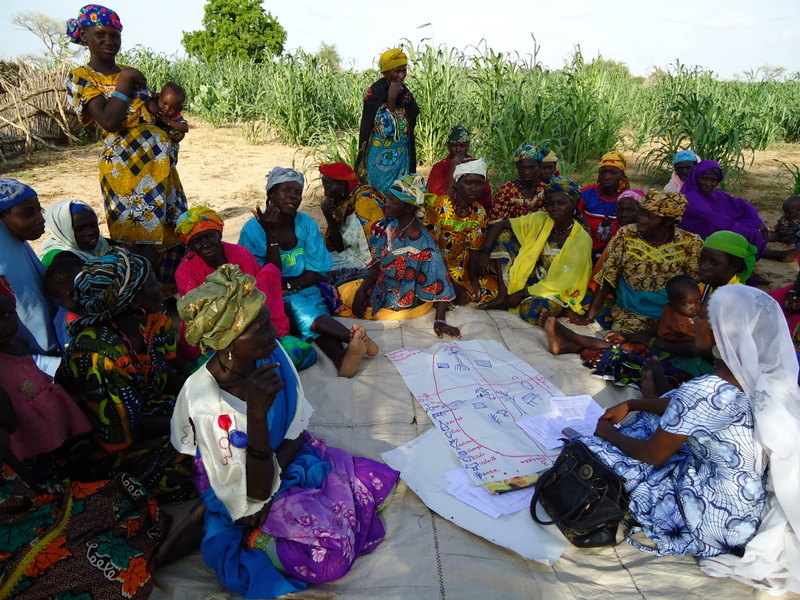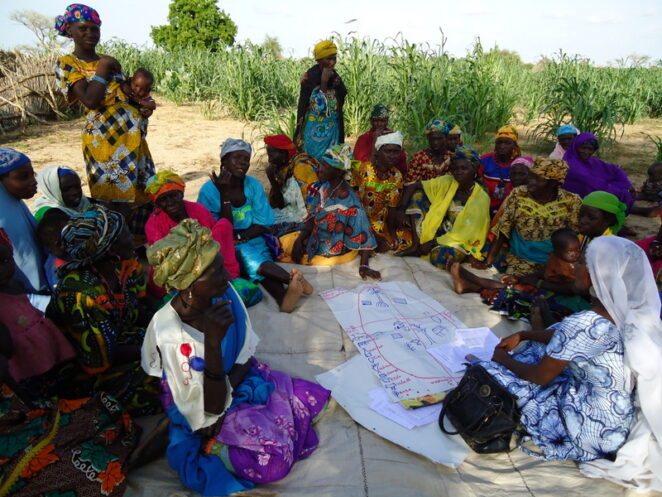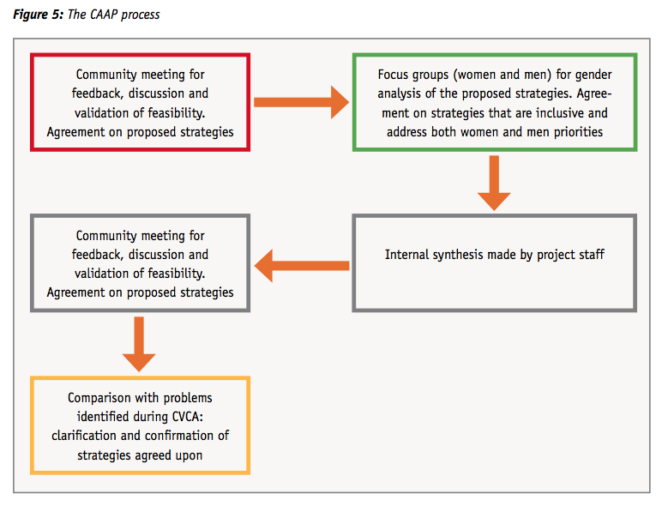Case-study /
Community adaptation action planning in Niger

This project example outlines the participatory process through which community-based adaptation action planning (CAAP) was carried out with 20 pastoralist and agro-pastoralist communities in the Dakoro district, Niger. CAAPs have allowed the communities to prioritise risks and make collective decisions on actions they can take to better adapt to the impacts of climate change.

Seasonal mapping at a women’s meeting in Dakoro district, Niger. © Ibrahim Niandou / CARE
Steps in developing CAAP
1. Preparation, training and collecting baseline data
A baseline study was undertaken, involving interviews with several community focus groups (men / women / young people), and using participatory appraisal tools and individual household questionnaires to understand how community members perceive climate change, its impact on their daily lives and their existing coping mechanisms. An institutional analysis was then carried out by CARE Niger and partner project staff mapping the relevant actors, institutions and programmes within the enabling environment, e.g. national government policies, market systems and services, civil society partners, etc.2. Participatory planning and identifying priorities for adaptation strategies
A thorough participatory analysis of the causes of vulnerability, through in-depth community discussions, enabled communities to identify and prioritise some adaptation strategies. Risk analysis trees were used to probe more deeply into the underlying causes of the identified risks and to uncover the role of social inequality in increasing the vulnerability of some groups within the communities. Parallel discussions were facilitated with gender equality-based focus groups to ensure the representative inclusion of the priorities of men, women and young people alike. a. Feasibility analysisAn analysis of economic, technical, social and environmental feasibility was completed using a matrix ranking exercise. The adaptation plans had to deliver outcomes in all four of the CBA framework strategy areas, and were also screened against future climate scenarios to ensure climate resilience.
b. Gender analysis
Each community then validated the outcomes of the feasibility analysis and further analysed the most effective strategies in regard to gender roles and relations. They assessed the implications for women, men, households and the community as a whole, in terms of time, labour, resources and social relations. Different roles and responsibilities were then negotiated between women and men in the communities to encourage a more sustainable and equitable division of labour as part of increasing the adaptive capacity of the community as a whole.

The CAAP process
3. Implementing community adaptation action plans
Each community came to an agreement about the main strategies suitable for both women and men to adapt to the impacts of climate change. The strategies were documented and transcribed on to large flipchart papers using agreed local symbols. This helped to share and communicate the plans to the entire community and ensured local understanding and ownership.Advocacy and social mobilisation to address the underlying causes of vulnerability
In Dakoro, one of the main issues affecting people’s ability to adapt to climate change was limited access to and control of the natural resources provided by the Tarka Valley, a critical dry season grazing area, which buffers the agro-pastoralist zone to the south and pastoralist zone to the north. This area is threatened by the impacts of climate change and demographic pressure. The project has worked with partner AREN (Association for the Revitalisation of Livestock Keeping in Niger) to develop a strategic advocacy plan for protecting the Tarka Valley, and to ensure that pastoralist rights over natural resources are taken into account locally and at national level.
Disaster risk reduction strategies to reduce the impact of hazards on vulnerable households
The project has supported the implementation of early warning and emergency response committees at community level. The committees collect rainfall records and share them with the local government vulnerability monitoring observatories (OSV), which then pass them on to local radio, as well as to higher governance levels of the early warning system. The radio broadcasts provide up-to-date information, informing decision-making on crop variety and planting timing, which reduces the risk of seed loss through multiple replanting and reduced harvests.
Promotion of climate-resilient livelihoods strategies
CAAP activities support climate resilient livelihoods, including the use of drought tolerant millet seed, tree planting for firebreaks and income production, and the rearing of goats rather than sheep, since they are more tolerant to drought conditions. In addition, savings and loans schemes and the promotion of crop warrantage, a system whereby harvests are ‘pre-purchased’ by the community group at an agreed average price, then stored and sold on the market at a later date when the price is higher, have enabled farmers to secure their harvests, pay off their debts and have a surplus for food.
Capacity development for local civil society and government institutions
The CBA planning process in itself has strengthened capacity to analyse and make informed decisions on resilience-building activities and more specific responses to climate change impacts. Rainfall information in the communities has particularly empowered local ownership of decision-making and innovation over rain-dependent activities.
To ensure local support for the implementation of the CAAPs, the plans were shared with the local authorities for consideration during Commune (local government level) Development Planning. It is envisioned that continuous dialogue between the communities, project team and local authorities will open the way for the commune development plans to integrate the communities’ adaptation priorities.
